Are you noticing damage to your books, wallpaper, or clothing and suspecting it might be the work of unseen pests? You could be dealing with silverfish, a familiar yet often unseen household pest.
Silverfish, known scientifically as Lepisma saccharina, are not actual fish but nocturnal insects that can cause significant damage to household items. These pests, characterized by their distinct silver color and fish-like movement, thrive in the dark, making them hard to spot.
In this blog, we will explore the practical strategies on how to get rid of silverfish from your home, ensuring your belongings are safe from their destructive habits.
What are Silverfish?
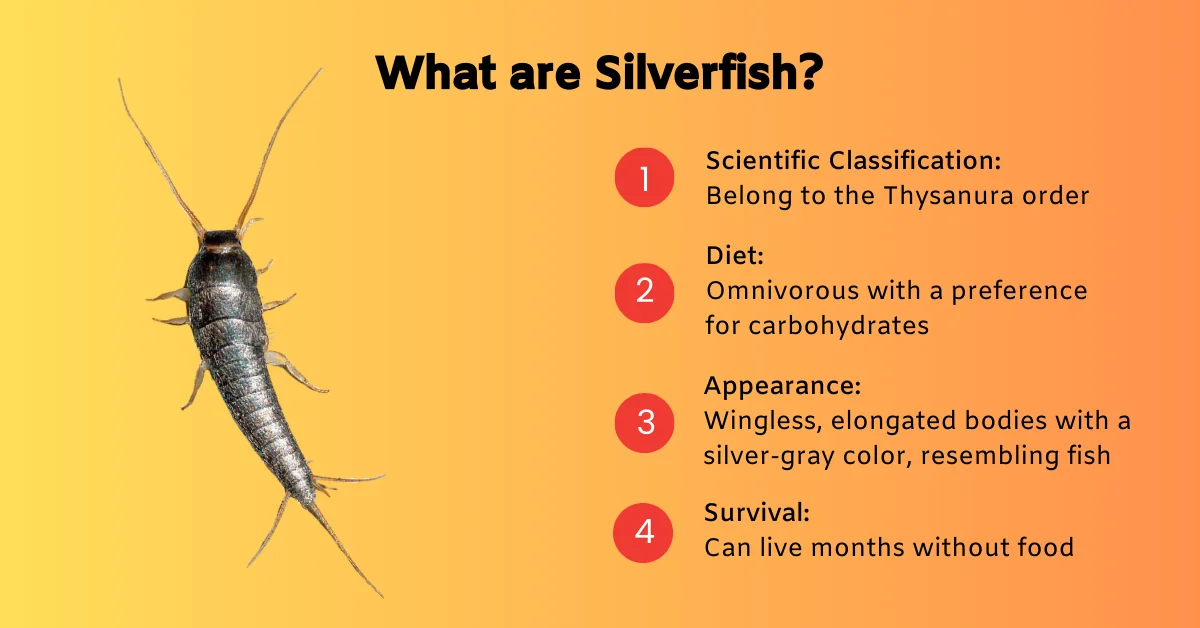
Silverfish, scientifically known as creatures of the Thysanura order, are omnivorous insects with a preference for carbohydrates. These wingless insects are notable for their elongated, silver-gray bodies that resemble fish, hence their name. A unique aspect of silverfish is their ability to survive months without food, making it challenging to ascertain whether they have been completely eradicated from your home.
How to Get Rid of Silverfish: Identify Them
To understand how to get rid of silverfish, first, you need to know how to identify them. Distinguishing silverfish is straightforward due to their unique physical characteristics.
- They possess elongated bodies measuring up to 3/4 inch, which tapers at the abdomen, ending in three long, antenna-like appendages.
- Their color ranges from silver to gray. Silverfish have a lengthy maturation period, taking up to 24 months to fully mature, which means a significant population may take time to develop.
How to Get Rid of Silverfish: Understanding Their Habitat
Recognizing their preferred habitats is essential to tackle how to get rid of silverfish.
- Silverfish are commonly found in environments where people reside and where there are carbohydrate-rich food sources.
- They prefer moist, cool areas such as basements, laundry rooms, and bathrooms and are primarily nocturnal.
- It’s common to find silverfish in bathtubs or sinks in the morning or see them moving around bookshelves during the night.
- Their diet varies, including wallpaper glue, book bindings, paper, clothing starch, fabrics, flour, cereal, leather, and even dead insects. This dietary diversity makes removing their food sources from home challenging.
How to Identify a Silverfish Infestation?
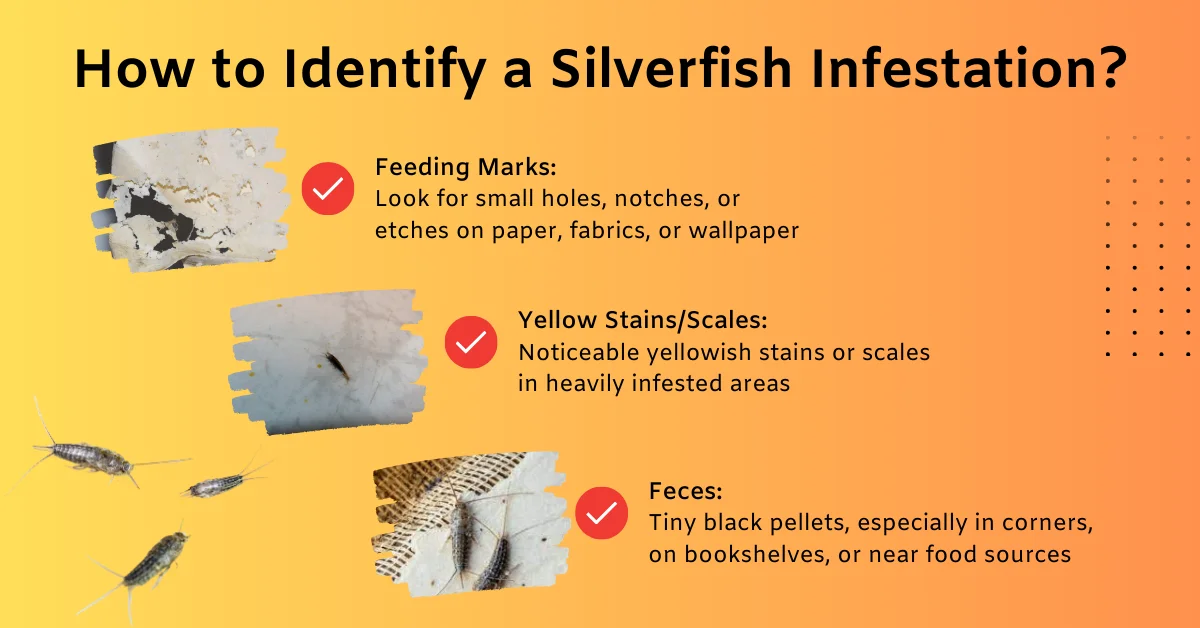
Detecting a silverfish infestation in your home isn’t always straightforward. Unlike some pests that leave evident traces, silverfish are more discreet. Recognizing the signs of their presence is crucial for timely and effective pest control. Here’s how to identify if you’re dealing with a silverfish infestation.
Key Indicators of Silverfish Presence
- Feeding Marks: One of the primary signs of a silverfish infestation is the distinct damage they cause to various surfaces. Look for small holes, notches, or etches, especially on paper, fabrics, or wallpaper. These marks result from silverfish scraping thin layers of these surfaces, as their jaws are not strong enough for heavy chewing.
- Yellow Stains or Scales: Silverfish can leave behind yellowish stains or scales in areas they frequent. These marks are often subtle but become noticeable in areas with heavy infestations.
- Feces: Silverfish feces appear as tiny black pellets. Spotting these in corners of rooms, bookshelves, or near potential food sources can indicate their presence.
Additional Signs to Consider
Apart from these specific indicators, signs of silverfish activity include book discoloration and irregular feeding marks on paper or fabric items. Since they have weak jaws, the damage they cause might not be immediately apparent but becomes more noticeable over time. To confirm a silverfish infestation, watch for these less obvious signs with the more direct indicators.
How to Get Rid of Silverfish: 8 Effective Ways
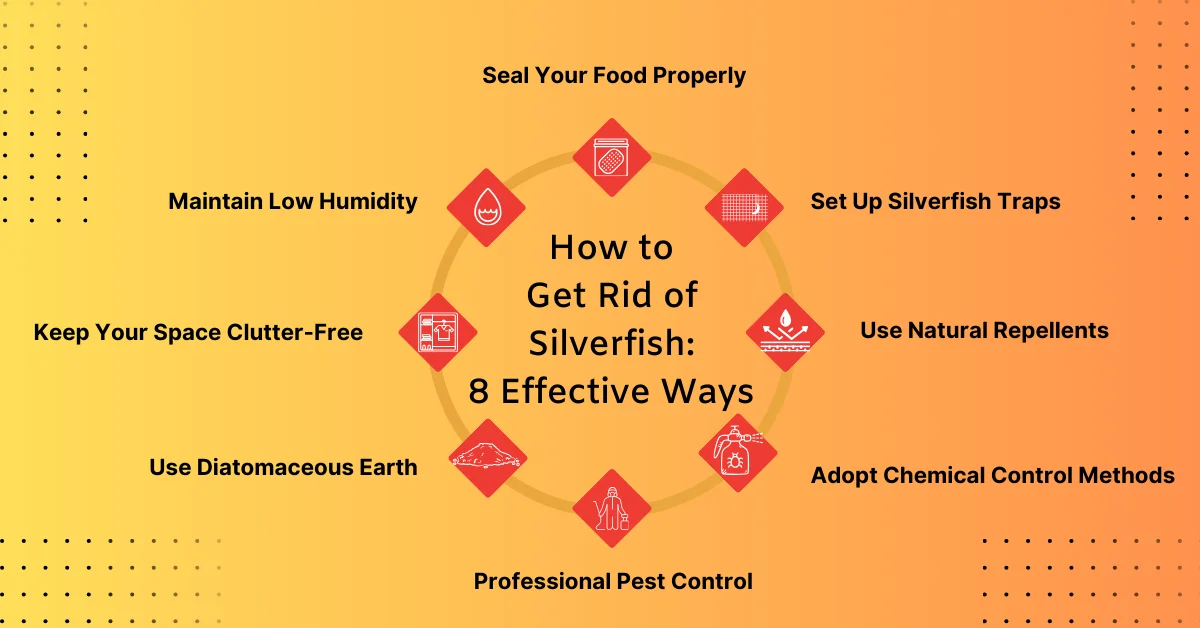
Silverfish, with their silvery scales and quick movements, can be unwelcome guests in any home. These nocturnal insects thrive in moist, humid environments and can cause damage to books, wallpapers, and various household items.
Below, we’ll explore how to get rid of silverfish, ensuring your home stays free from these pests and preventing future infestations.
- Seal Your Food Properly
It’s essential to store cereals, flour, sugar, and other starchy foods in airtight containers. This practice prevents silverfish from accessing these food sources, as they are attracted to these types of items. Ensuring that all your pantry items are securely stored can significantly reduce the likelihood of silverfish infestations.
It is crucial to conduct frequent inspections of your pantry. Make it a routine to check that all containers are still tightly sealed. This helps maintain the freshness of your food and acts as a preventive measure against silverfish and other pests that might be attracted to your food supplies.
- Maintain Low Humidity
An effective strategy is to utilize dehumidifiers in areas of your home that are high in moisture, such as basements. Silverfish thrive in humid environments, so reducing humidity creates a less hospitable environment. Dehumidifiers help maintain a dry atmosphere, which is less attractive to these pests.
Proper ventilation in bathrooms and kitchens is vital. These areas typically have higher humidity levels due to activities like cooking and showering. Ensuring these rooms are well-ventilated helps reduce moisture accumulation, making them less appealing to silverfish. Consider using exhaust fans or opening windows to improve air circulation.
Addressing leaky pipes and sealing any cracks or crevices is another key step in controlling humidity and moisture in your home. Leaks can contribute to damp conditions, which are ideal for silverfish. Regular maintenance and prompt repairs of any leaks can significantly help in keeping your home dry and less prone to silverfish infestations.
- Keep Your Space Clutter-Free
It’s important to clean areas where paper and fabric accumulate regularly in your home. Silverfish are attracted to these materials and often use them as hiding and breeding spots. By frequently cleaning and vacuuming spaces like bookshelves, closets, and storage rooms, you reduce the chances of silverfish finding a suitable habitat in your home.
Take the time to sort through and discard items that are no longer needed, such as old newspapers, magazines, and unused textiles. These items are potential food sources and nesting grounds for silverfish. Keeping your home free of such clutter minimizes the areas where silverfish can thrive and contributes to a more organized and pleasant living space.
Maintaining tidy and well-organized storage areas is crucial in preventing silverfish infestations. Ensure that items are stored properly and boxes are sealed. Using plastic storage containers instead of cardboard can also be beneficial, as silverfish can feed on cardboard. An orderly storage system deters silverfish and makes it easier to spot any signs of infestation early on.
- Use Diatomaceous Earth
Diatomaceous earth is an effective, non-toxic powder that can help control silverfish populations. Apply this powder in areas where silverfish activity has been observed, particularly in the evenings when these nocturnal insects are more active. Focus on corners, baseboards, and behind furniture, as these are common hiding spots for silverfish.
Diatomaceous earth must be applied consistently over several days to be effective. Silverfish may not come into contact with the powder immediately, so repeated application ensures that more insects are affected. Regularly check the treated areas and reapply the powder as needed to maintain its effectiveness, especially after cleaning or vacuuming.
- Set Up Silverfish Traps
To maximize the effectiveness of silverfish traps, place them in areas where you’ve noticed high activity levels. Common spots include bookshelves, closets, and other dark, secluded areas where silverfish might hide or feed. The correct positioning of these traps is crucial for capturing as many silverfish as possible.
When setting up these traps, consider safety. Keep them out of reach of children and pets to prevent accidental contact or ingestion. Additionally, avoid placing traps near food preparation or storage areas to prevent contamination. Always handle and dispose of the traps according to the manufacturer’s instructions.
- Use Natural Repellents
Essential oils are a natural and pleasant-smelling way to deter silverfish. Mix oils like cedar, cinnamon, or cloves with water and spray the mixture in areas prone to silverfish infestation. These oils act as natural repellents and help keep silverfish at bay without harsh chemicals.
Another effective method is to place cedar shavings directly in areas where silverfish are frequently found. The scent of cedar is a natural deterrent for silverfish and can be a simple yet effective way to reduce their presence in your home.
- Adopt Chemical Control Methods
Use insecticides only for significant infestations. Effective ingredients include synergized pyrethrin, bifenthrin, cyfluthrin, tetramethrin, and phenothrin. Some studies suggest that 0.05% or 0.20% chlorfenapyr in baits can be particularly effective.
Always follow safety instructions and ensure compliance with local regulations. Avoid using near food, water, or where children and pets are present.
- Professional Pest Control
In cases of severe silverfish infestation, it may be necessary to seek professional help. Pest control professionals can thoroughly assess your home to identify the extent of the problem and the most affected areas.
Professional pest control services can provide customized treatment plans tailored to your situation. They have access to various tools and methods that may be more effective and long-lasting than DIY solutions. Their expertise can ensure that the silverfish problem is dealt with efficiently and prevent future infestations.
Combining these methods can create a comprehensive approach to managing and eliminating silverfish from your home. Whether you opt for DIY traps or natural repellents, or seek professional pest control services, each strategy contributes significantly to the overall effort of how to get rid of silverfish. Implementing a blend of these techniques ensures a more effective and lasting solution, helping you maintain a silverfish-free environment in your home.
Experience Effective Pest Control Services With Truly Pest Solution!

Tackling a silverfish infestation requires a multifaceted approach. Professional pest control offers a tailored solution for persistent or severe cases, ensuring a thorough and lasting resolution to the problem. Remember, the key to successful silverfish eradication lies in consistency and attention to detail in implementing these strategies. This guide provides insights on how to get rid of silverfish, ensuring a thorough and lasting resolution.
At Truly Pest Solution, our Intelligent Snow Gel Service (ISGS), part of our Integrated Pest Management Program, we offer a revolutionary approach to combat and ensure a safe and effective solution to protect your home from the damaging effects of silverfish. But with ISGS, you can rest assured that your home is protected by the latest pest control innovation.
Contact Truly Pest Solution today.
Book a meeting now!
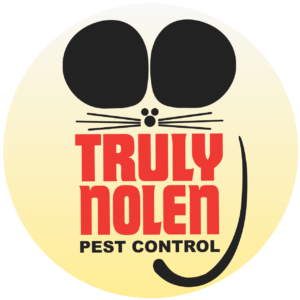
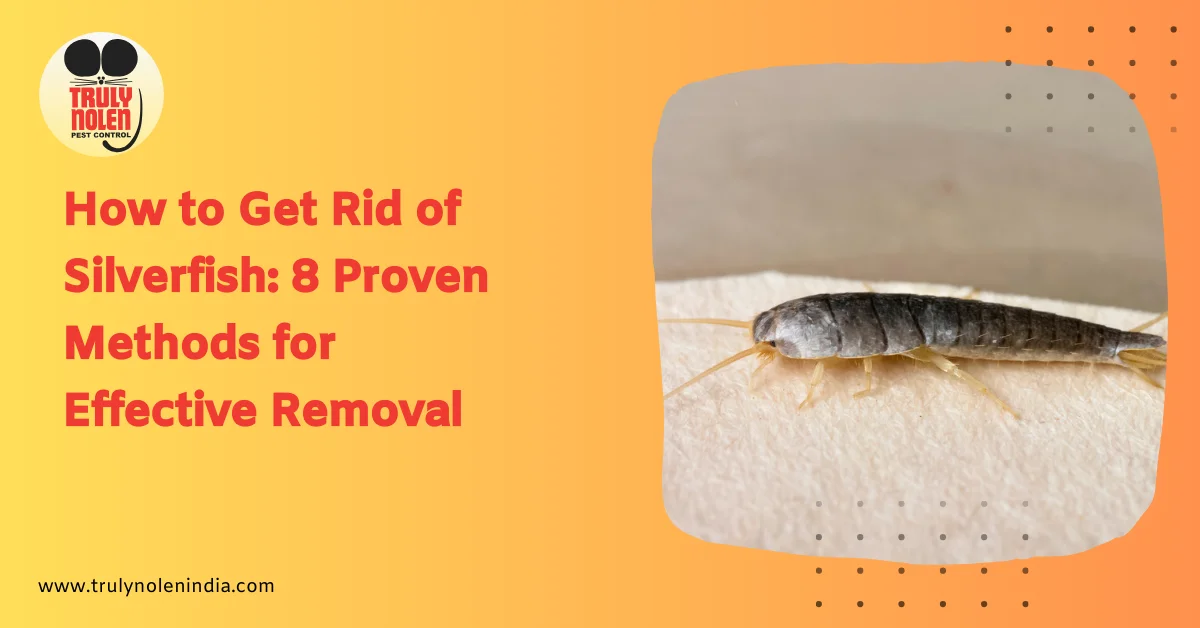
Leave a Reply